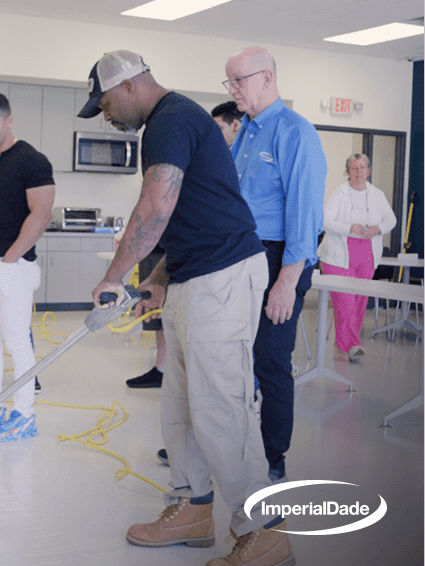Did you know that every year, there are about 2 million work-related accidents that result in an injury in the US? That’s almost 200 workplace injuries per day.
Simply put, workplace injuries are bad for business.
Workplace injuries lead to unhappy employees, which means increased employee turnover. It could also mean downtime and higher costs as employees file for workers’ compensation and disability.
Personal protection equipment is crucial to protecting employees, avoiding workplace injury, and keeping the effects of a workplace injury at bay.
To prevent workplace injuries from occurring, companies are often required by OSHA to provide their employees with personal protective equipment, or PPE for short. PPE can be an article of clothing, an accessory, or a piece of equipment.
In this article and video, we will review everything you need to know about personal protection equipment so you can keep your staff safe.
What is PPE?
OSHA defines PPE as “equipment worn to minimize exposure to hazards that cause serious workplace injuries and illnesses. These injuries and illnesses may result from contact with chemical, radiological, physical, electrical, mechanical, or other workplace hazards.”
PPE Examples
Personal protective equipment may include items such as:
- Gloves
- safety glasses
- Shoes
- earplugs or earmuffs
- hard hats
- Respirators
- coveralls, vests and/or full-body suits
- …and more!
Importance of PPE
It is not just enough to provide the proper personal protection equipment to your employees. The PPE must be adequate for the task at hand as well as properly fitting.
If the personal protective equipment does not fit properly, it can make the difference between an accident or injury.
Personal protective equipment guidelines and regulations is addressed in specific OSHA standards for general industry, maritime, and construction.
OSHA requires that many categories of personal protective equipment meet or be equivalent to standards developed by the American National Standards Institute (ANSI).
The below link provides OSHA standards and documents related to personal protective equipment.
OSHA Standards
What are the 6 Main Types of PPE?
The six main types of PPE are eye and face protection, head protection, hand and arm protection, foot and leg protection, body protection, and hearing protection.
1. Eye and Face Personal Protection Equipment
The purpose of eye and face protection is to reduce the risk of anything, such as debris or a chemical spill, from coming into contact with a worker’s eyeballs, nose, and mouth, and to protect against any other form of accidental contamination to the face.

Some eye and face protection examples include safety glasses or goggles, face masks, and respirators.
2. Head Personal Protection Equipment
Head PPE is meant to protect the worker against falling objects and extreme temperatures.
Hard hats are a popular form of head protection against falling objects, while hooded balaclavas made from a thick fabric are common for protecting workers from cold weather.
3. Hand and Arm Personal Protection Equipment

Hand and arm protection aims to give the worker a layer of protection against sharp or hazardous objects and extreme temperatures.
Hand and arm protection most often comes in the form of gloves, like chemical-resistant gloves, general-purpose gloves, cut or puncture-resistant gloves, and impact gloves.
4. Foot and Leg Personal Protection Equipment
Foot and leg protection is a little unique in that it is meant to protect the feet and legs from injury while also providing the worker with comfort. The right foot and leg protection is essential for a safe and productive work environment.

Some examples of leg and foot protection include steel-toed work boots, heavy-duty canvas work pants, and polypropylene shoe covers.
5. Body Personal Protection Equipment
The purpose of body protection is to provide workers in low-lit areas with high-visibility clothing or to provide workers with protective items that can used to prevent injuries from heavy lifting.
Some examples of body protection include hi-vis jackets, hi-vis vests, and back support belts.
6. Hearing Personal Protection Equipment
Hearing protection helps protect workers from future eardrum damage and hearing loss by reducing the noise of loud machines.
This type of PPE comes in the form of disposable earplugs and various earmuffs, such as behind-the-head earmuffs, cap-mount earmuffs, and over-the-head earmuffs.
Final Thoughts
Different types of work require using unique types of PPE, and it’s important to ensure you’re giving your workers the right type of PPE for the job. Yes, it is the responsibility of the employer to provide the right personal protection equipment for the job.
The best way to ensure the equipment is used correctly is to ensure a PPE program is implemented when PPE is provided.
A PPE program should address the hazards present, the selection, maintenance, and use of PPE; the training of employees; and monitoring of the program to ensure its ongoing effectiveness.
At Imperial Dade, we have over 600 individual PPE products in stock, spanning across all six of the main PPE categories. We also offer PPE program counseling to ensure you build the safest and most effective program.
From heavy-duty general-purpose gloves to disposable foam ear plugs and from chemical impact goggles to particulate respirators, Imperial Dade has got you covered. If you’re interested in hearing more about what we can do to help protect your workers, call your nearest Imperial Dade facility today.
We’ll set you up for a free consultation with one of our specialists from your industry so that you can get the most out of what we have to offer.
